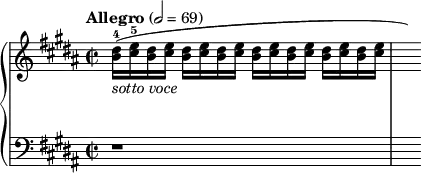Étude Op. 25, No. 6, in G-sharp minor, is a technical study composed by Frédéric Chopin focusing on thirds, trilling them at a high speed. Also called the Double Thirds Étude, it is considered one of the hardest of Chopin's 24 Études, ranking the highest level of difficulty according to the Henle difficulty rankings.[1]
Excerpt from the beginning of the Étude Op. 25 No. 6

Technical difficulties
The most conspicuous difficulty is the trilling of thirds quickly, such as in the beginning of the piece. However, there are also other difficulties, such as playing a chromatic scale in thirds with one hand (m. 5), and alternating chords with fingerings 3–5 and 1–2 (m. 27). At one point (m. 31), both hands do this together in descending diminished seventh chords.[2]
References
- ↑ "Frédéric Chopin – Etudes". Henle Verlag. Retrieved 13 September 2018.
- ↑ Analysis of Chopin's Etudes, Op. 25, Anh Tran, ourchopin.com
External links
- Études, Op. 25: Scores at the International Music Score Library Project
- Op. 25, No. 6 played by Josef Lhévinne
- Op. 25, No. 6 played by Alfred Cortot
- Op. 25, No. 6 played by Claudio Arrau
- Op. 25, No. 6 played by Sviatoslav Richter
- Op. 25, No. 6 played by Adam Harasiewicz
- Op. 25, No. 6 played by Vladimir Ashkenazy
- Op. 25, No. 6 played by Maurizio Pollini
This article is issued from Wikipedia. The text is licensed under Creative Commons - Attribution - Sharealike. Additional terms may apply for the media files.